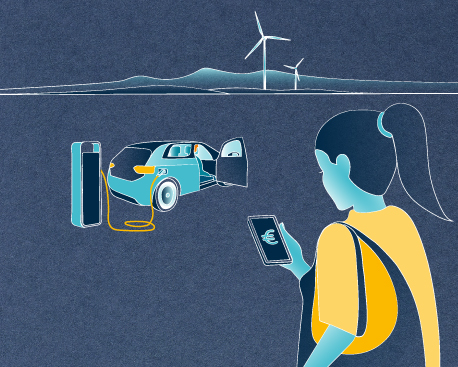Batteries for electric cars: Fact check and answers to the most important questions about electric mobility
How well do electric cars perform environmentally? How will their range, economic efficiency and charging infrastructure develop in the long term? Will electric mobility mean job losses? These and many other questions to do with the battery value chain are addressed by the Fraunhofer ISI in a Policy Brief, which was presented at the Battery Forum Germany in Berlin. Main message: there is nothing to stop the widespread market diffusion of electric cars between 2020 and 2030+, although numerous challenges still have to be addressed.
Update 2025
An update to this policy brief was published on 22 May 2025.

What are the trends in electric mobility and electric car batteries? What is the environmental impact of electric cars? What progress has been made in terms of range, what happens to the used batteries, and how high is the risk of fire? Fraunhofer ISI addresses these and many other questions along the entire battery value chain in its policy brief “Batteries for Electric Cars – Fact Check and Need for Action – An Update”.
The technological maturity of batteries for electric cars and whether these make economic and environmental sense is still being questioned by critics today, even though electric mobility has already been evolving for a long time. The start of 2020 marked more than 7.5 million e-cars on roads worldwide, and their share in global car sales is estimated as ranging between 25 and 75% from 2030 depending on the market study. This has a major impact on the global demand for lithium-ion batteries (LIB) and their capacities, which are expected to increase from 500 - 1,500 GWh (around 2025) up to 1,000 - 6,000 GWh (from 2030).
Battery cells made in Europe
Battery cell production capacities of almost 600 GWh have been announced in Europe by 2030 – half of which is to be located in Germany. This is equivalent to a 20% share of global battery cell demand on average, and is intended to meet the expected demand of European automobile manufacturers.
Given the decisive market ramp-up phase that is expected between 2020 and 2030, Fraunhofer ISI‘s fact check provides an overview of challenges that are the subject of controversial discussion along the battery value chain and outlines the existing needs for action in this period. The authors conducted a meta-analysis of a wide range of literature including their own studies to answer 12 key questions such as:
How are batteries developing and what ranges can we expect?
Over the last ten years, the energy density of large LIB battery cells used in e-cars has almost doubled and could double again by 2030. However, in order to reach real driving ranges of more than 600 kilometers, space and weight-reducing innovations and strategies are needed in the vehicles down to the battery system level in addition to further advances in LIB batteries. The acceptance and demand of e-car buyers will continue to improve over the next decade as the range, economic efficiency and charging infrastructure for electric cars also improve.
Do electric cars have a better environmental footprint than conventional cars?
The latest electric cars on the market score much better on environmental performance across their entire service life than conventional passenger cars. The environmental performance of e-cars improves even further if more renewable energy sources are used to produce the batteries and the power used for charging and driving in the future. Like all passenger cars, however, e-cars also have negative environmental impacts, which must be reduced, for example, by changing our mobility behavior.
Does electric mobility lead to job losses?
Overall, many studies indicate there will be a loss of jobs in the automobile industry and its suppliers. Although the job effects from battery cell production are limited, the job effects resulting from the upstream and downstream value chains are still relevant – and therefore establishing cell producers in Europe (and Germany) is extremely important. The job losses in the automobile industry and its suppliers are offset by job gains in other areas such as electricity production and distribution or the construction of charging infrastructure. Regions and businesses particularly affected by structural change may need to be supported by proactive industrial and employment policy measures, so that – together with natural age-related fluctuation – structural change can be shaped in a socially acceptable way.
The Fraunhofer Institute for Systems and Innovation Research ISI analyzes the origins and impacts of innovations. We research the short- and long-term developments of innovation processes and the impacts of new technologies and services on society. On this basis, we are able to provide our clients from industry, politics and science with recommendations for action and perspectives for key decisions. Our expertise is founded on our scientific competence as well as an interdisciplinary and systemic research approach.